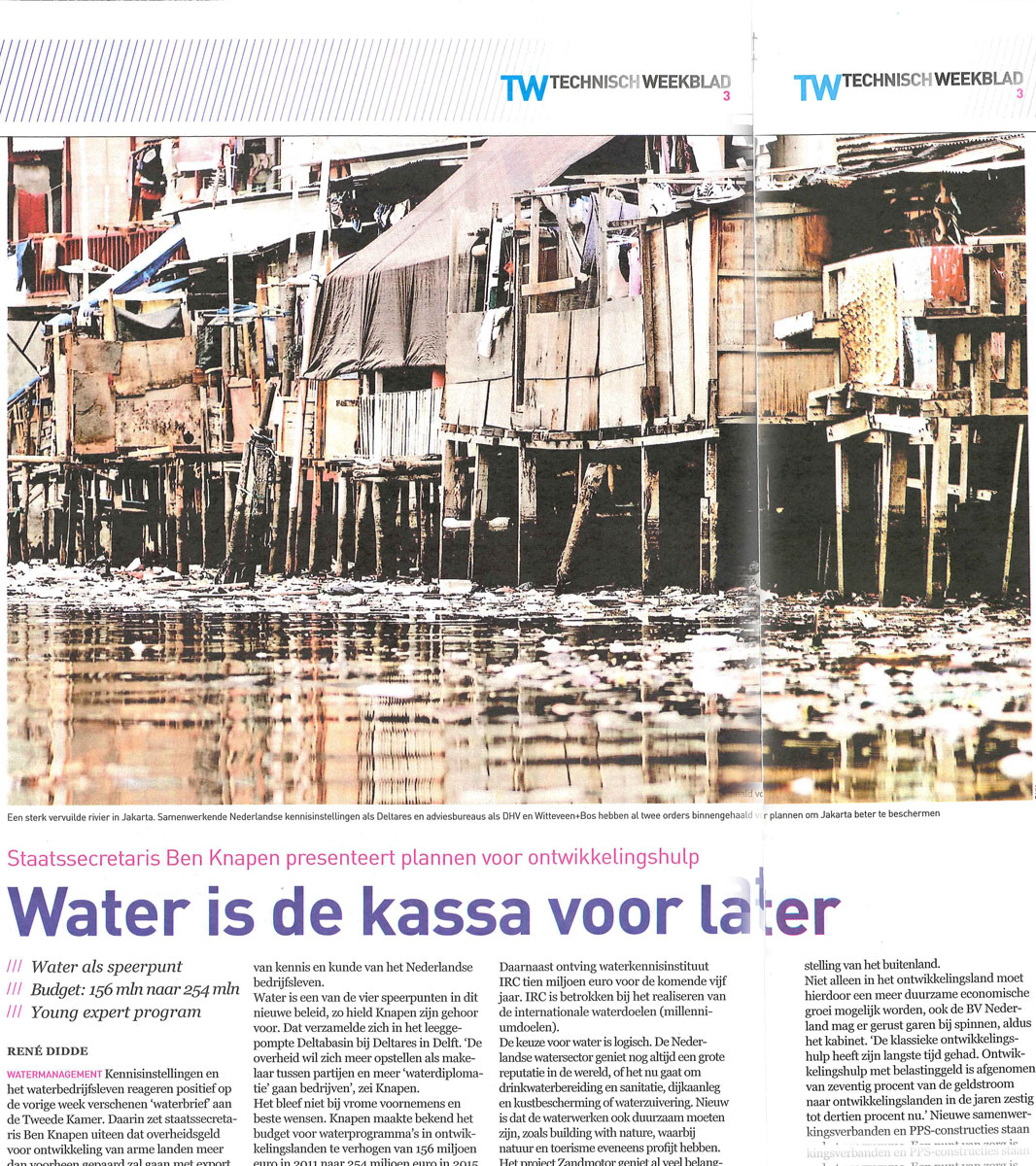The Dutch water sector applauds the governmental budget increase for water-related programs in developing countries.
The long Dutch struggle with water led to several disasters and lots of knowledge.
Now the Dutch government wants its companies and universities to share that expertise with developing countries in their struggles with water. The government has chosen water as one of the four focus areas for development aid and will increase the budget for water-related aid from 156 million in 2011 to 254 million in 2015.
“In some parts of the world there is sometimes a surplus of water that leads to flooding,” says professor of hydraulic engineering, Huib de Vriend. “In other regions there is a scarcity of water. The water problems we’re facing worldwide are enormous and we have expertise to help.”
Professor of experimental hydrology, Stefan Uhlenbrook, agrees. “The Netherlands is leading in water knowledge, so this is a smart move. It’s also wise to focus on some areas, where one can have a strong impact, rather than doing lot of things without results.” Uhlenbrook is also a professor of hydrology at Unesco-IHE Delft – an institute of higher education that focuses on water-related subjects in developing countries.
Uhlenbrook stresses that the Netherlands should work closely together with developing countries: “Projects should be demand driven. Listening to the partners is very important, as they know what is needed. It’s wrong to think that technical solution X works in the Netherlands and therefore will work somewhere else as well. Therefore, lots of research to develop sustainable local solutions is needed. For instance, 30 years ago Germany provided African countries with tractors. After a couple of years some parts of the tractors failed, but no one had trained the locals about maintenance or where they could get new parts. In the end the tractors were useless once they broke down. This should not happen with water projects.”
Saket Pande, assistant professor of hydrology, emphasizes that it’s complicated for Dutch companies to work in developing countries: “It happens very often that there is a mismatch. Take the water supply, for instance. Developing countries need better infrastructures, but it’s not easy for Dutch companies to work together with them. As the quality of the infrastructure is very different in the Netherlands, will they know how to handle a different system? In India, where I was born, the water supply is handled by a huge public institution. Foreign companies may not even be allowed to enter developing markets without unpopular reforms that threaten several public sector jobs. This should all be taken into account. It could be very complicated. Collaboration between the Dutch and local companies as equal partners is the only way to do it.”
According to Pande, De Vriend and Uhlenbrook, water scarcity should be one of the main focus points. “There is water scarcity in urban areas that are rapidly becoming densely populated,” De Vriend says. “The people in booming cities should get access to good quality drinking water, but this often leads to decreases in the groundwater table, sometimes as far away as a couple of hundred meters.”.
He also stresses that no matter how much expertise the Netherlands has, it should not only share knowledge in development countries: “Dutch companies and universities should also learn from the experience they gain and approaches they see in foreign countries.”
It can hardly be a coincidence that Medical Delta researchers presented their unique and possibly lifesaving views of the heart on Valentine’s Day. Lead author, Hortense Kirisli MSc (Erasmus MC and Leiden University MC), will present a paper in Orlando, Florida, containing images made with a prototype workstation that combines anatomical information from a CT-scan, with functional information from an MRI, in one interactive, three-dimensional image of the heart. Not only does the image show which coronary arteries have been clogged up and to what extent, but it also reveals how the perfusion of the heart muscle fed by those arteries has been affected.
Heart patients are routinely scanned with both CT (X-ray computer tomography) and MRI or PET-scan. The CT scanning technique depicts the anatomy of the heart, while the latter two techniques map the actual perfusion – or nourishing flow of blood through the heart muscle. These scans may be taken days apart and at different locations. And yet a cardio-radiologist must consult and compare the separate images when deciding which arteries to clear in order to improve the heart’s condition. The researchers hope to assist this decision-making with their combined image.
The 3D-data sets of both technologies are fitted together based on the anatomy of the heart’s left ventricle, which shows up in both images. The images do not have to fit down to the last millimetre, says Dr Wiro Niessen (TU Delft’s faculty of Applied Sciences and Erasmus MC), who is coordinating the project with Dr Hans Reiber (LUMC). Perfusion data aren’t very sharp to begin with, but what must be visible is which artery feeds what part of the heart muscle.
Clever as this imaging may be, it has yet to prove its diagnostic value. Dr Niessen says the team is still working on the protocol for clinical evaluation. Essentially they want doctors to re-examine some older cases with the new technique to see if it improves their diagnoses.
The team presenting the paper consists of researchers from Erasmus MC, Leiden UMC and TU Delft, working together in the Medical Delta consortium. The work is part of the ‘Heart in 3D’ project.
H.A. Kirsli et al, W.J. Niessen: ‘A patient-specific visualization tool for comprehensive analysis of coronary CTA and perfusion MRI data’.



Comments are closed.